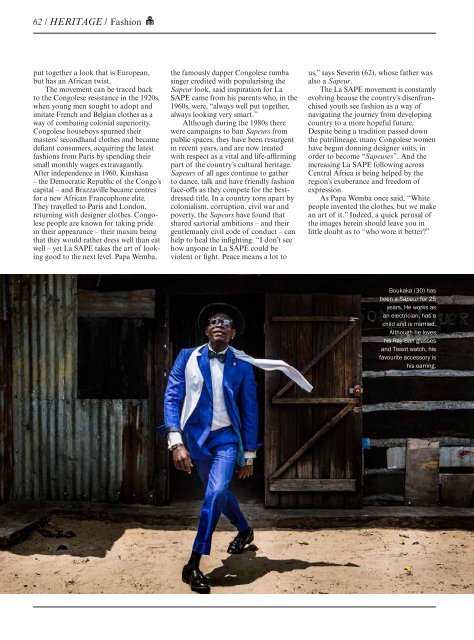january-2019
January Issue
January Issue
Create successful ePaper yourself
Turn your PDF publications into a flip-book with our unique Google optimized e-Paper software.
62 / HERITAGE / Fashion<br />
HERITAGE / 63<br />
put together a look that is European,<br />
but has an African twist.<br />
The movement can be traced back<br />
to the Congolese resistance in the 1920s,<br />
when young men sought to adopt and<br />
imitate French and Belgian clothes as a<br />
way of combating colonial superiority.<br />
Congolese houseboys spurned their<br />
masters’ secondhand clothes and became<br />
defiant consumers, acquiring the latest<br />
fashions from Paris by spending their<br />
small monthly wages extravagantly.<br />
After independence in 1960, Kinshasa<br />
– the Democratic Republic of the Congo’s<br />
capital – and Brazzaville became centres<br />
for a new African Francophone elite.<br />
They travelled to Paris and London,<br />
returning with designer clothes. Congolese<br />
people are known for taking pride<br />
in their appearance – their maxim being<br />
that they would rather dress well than eat<br />
well – yet La SAPE takes the art of looking<br />
good to the next level. Papa Wemba,<br />
the famously dapper Congolese rumba<br />
singer credited with popularising the<br />
Sapeur look, said inspiration for La<br />
SAPE came from his parents who, in the<br />
1960s, were, “always well put together,<br />
always looking very smart.”<br />
Although during the 1980s there<br />
were campaigns to ban Sapeurs from<br />
public spaces, they have been resurgent<br />
in recent years, and are now treated<br />
with respect as a vital and life-affirming<br />
part of the country’s cultural heritage.<br />
Sapeurs of all ages continue to gather<br />
to dance, talk and have friendly fashion<br />
face-offs as they compete for the bestdressed<br />
title. In a country torn apart by<br />
colonialism, corruption, civil war and<br />
poverty, the Sapeurs have found that<br />
shared sartorial ambitions – and their<br />
gentlemanly civil code of conduct – can<br />
help to heal the infighting. “I don’t see<br />
how anyone in La SAPE could be<br />
violent or fight. Peace means a lot to<br />
us,” says Severin (62), whose father was<br />
also a Sapeur.<br />
The La SAPE movement is constantly<br />
evolving beause the country’s disenfranchised<br />
youth see fashion as a way of<br />
navigating the journey from developing<br />
country to a more hopeful future.<br />
Despite being a tradition passed down<br />
the patrilineage, many Congolese women<br />
have begun donning designer suits, in<br />
order to become “Sapeuses”. And the<br />
increasing La SAPE following across<br />
Central Africa is being helped by the<br />
region’s exuberance and freedom of<br />
expression.<br />
As Papa Wemba once said, “White<br />
people invented the clothes, but we make<br />
an art of it.” Indeed, a quick perusal of<br />
the images herein should leave you in<br />
little doubt as to “who wore it better?”<br />
Boukaka (30) has<br />
been a Sapeur for 25<br />
years. He works as<br />
an electrician, has a<br />
child and is married.<br />
Although he loves<br />
his Ray-Ban glasses<br />
and Tissot watch, his<br />
favourite accessory is<br />
his earring.<br />
“The Sapeurs<br />
will spend<br />
US$3,000 on a<br />
suit when they<br />
don’t even have<br />
running water”<br />
© Tariq Zaidi<br />
Above: Maxim (43) has been a Sapeur<br />
since he was seven years old. He mixes<br />
labels such as Yves Saint Laurent and<br />
Christian Dior with suits that he has made<br />
himself. Now married and the father of<br />
two children, he teaches others the art of<br />
dressing elegantly. Left: Nino (31) takes a<br />
stroll through his neighbourhood with his<br />
Mississippi-style wooden pipe. He paints<br />
houses and fixes roofs, but in Sapeur<br />
mode, he’s treated like a rock star.
















